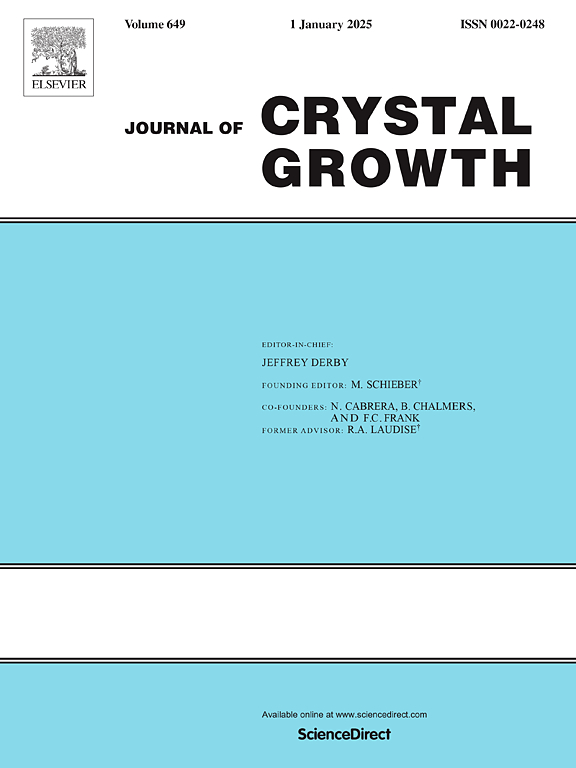Growth of rutile GeO2 nanoneedles supported by in situ microscopy
IF 2
4区 材料科学
Q3 CRYSTALLOGRAPHY
引用次数: 0
Abstract
Rutile GeO2 nanoneedles were grown using a method involving eutectics of the Ge-GeO2 system and chemical transport reactions. The synthesis was carried out at 1095–1215 K in a miniature cell, which is evacuated and sealed, enclosing all products that are generated in reactions. In this cell, one can observe the processes throughout all stages of the method in situ via video microscopy. Differences in the process development depending on the heating time and mass ratio of reagents were revealed. Depending on the latter condition, two ways for growing nanoneedles have been proposed. The needles and other reaction products were studied ex situ using SEM, dark-field and bright-field TEM, HRTEM, SAED, EDX and Raman spectroscopy. The nanoneedles are single crystals without any amorphous surface layer. They are rutile GeO2 and belong to the tetragonal crystal system. Their longitudinal growth direction is . The spacings between lattice planes in the longitudinal and lateral directions are found to be 2.8 Å and 3.2 Å respectively. At higher temperatures, larger micrometre-sized crystals of rutile GeO2 with various morphologies are formed.
原位显微镜支持下金红石型GeO2纳米针的生长
采用Ge-GeO2体系共晶和化学传递反应的方法制备了金红石型GeO2纳米针。在1095-1215 K的温度下,在一个微型细胞中进行合成,该细胞是真空和密封的,封闭了反应中产生的所有产物。在这个细胞中,人们可以通过视频显微镜原位观察方法所有阶段的过程。结果表明,不同的加热时间和试剂的质量比对反应的影响不同。根据后一种条件,提出了两种生长纳米针的方法。采用SEM、暗场和明场TEM、HRTEM、SAED、EDX和拉曼光谱对针和其他反应产物进行了非原位研究。纳米针是单晶,没有任何非晶表面层。它们是金红石型GeO2,属于四方晶系。它们的纵向生长方向为001。在纵向和横向上,晶格面间距分别为2.8 Å和3.2 Å。在较高的温度下,形成具有不同形貌的较大微米尺寸的金红石型GeO2晶体。
本文章由计算机程序翻译,如有差异,请以英文原文为准。
求助全文
约1分钟内获得全文
求助全文
来源期刊

Journal of Crystal Growth
化学-晶体学
CiteScore
3.60
自引率
11.10%
发文量
373
审稿时长
65 days
期刊介绍:
The journal offers a common reference and publication source for workers engaged in research on the experimental and theoretical aspects of crystal growth and its applications, e.g. in devices. Experimental and theoretical contributions are published in the following fields: theory of nucleation and growth, molecular kinetics and transport phenomena, crystallization in viscous media such as polymers and glasses; crystal growth of metals, minerals, semiconductors, superconductors, magnetics, inorganic, organic and biological substances in bulk or as thin films; molecular beam epitaxy, chemical vapor deposition, growth of III-V and II-VI and other semiconductors; characterization of single crystals by physical and chemical methods; apparatus, instrumentation and techniques for crystal growth, and purification methods; multilayer heterostructures and their characterisation with an emphasis on crystal growth and epitaxial aspects of electronic materials. A special feature of the journal is the periodic inclusion of proceedings of symposia and conferences on relevant aspects of crystal growth.
 求助内容:
求助内容: 应助结果提醒方式:
应助结果提醒方式:


